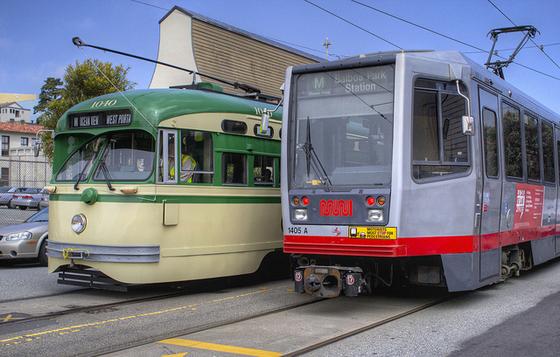Of Muni’s 32 streamliner PCC streetcars currently in active service or under restoration, the most historic is almost certainly No. 1040. It was the very last one of some 5,000 PCCs to be built in North America, and just rejoined the fleet after a full restoration that paid particular attention to preserving its original features.
Its historic status has instantly made it a favorite target of photographers. We’re seeing a lot of great shots of it in our Flickr Group. We thought we’d share this one, by knelson27, taken on our recent charter of No. 1040. It’s posed next to an LRV near the original end of the M-line at Broad and Plymouth. And yes, the F-line PCCs also carry route signs for the other Muni surface streetcar routes, In case they’re needed for shuttle service.
Comments: 3
Comments are closed.

Any reason the bumper wasn’t painted black? Was silver the original color on 1040? Also, on #1 why wasn’t the number “1” painted above the center front window instead of the left front panel?
The late SFMTA Board Member Cam Beach suggested, and we agreed, as did Muni management, that we should interpret 1040 to the period that most people remembered. The car only ran with a black bumper for two years when it was first delivered. When it was converted from a two-crew member operation to a single operator in 1954, minor modifications, including the silver bumper and moving the number above the roll sign, were made. That’s how we have it.
Similar thinking on Car No. 1. During periods it operated in the gray livery (1912-1944 and 1962-2008), the number “1” moved all over its ends. Left panel, right panel, centered above operator’s window. We put it on the right because that was consistent with other features of the car as restored, particularly the glassed-in end sections, which were added to the original car by 1920. Around that same time, the number was moved from the left to the right panel, so that dash signs could be hung on the left panel. Later, it was moved over the center end window, so ads could be mounted on the right end panels. As restored, the car is accurately interpreted to the 1920s, the earliest accurate interpretation it could have, given the decision (again led by Cam Beach) to leave the end sections glassed in for both comfort and safety reasons.
Hope this clarifies things.
Thanks for the explanations. Too bad the end sections on #1 were glassed in for “comfort and safety”. Cable car riders seem to do okay hanging on the steps.